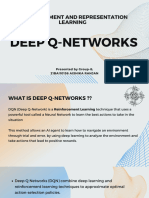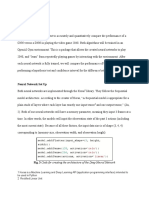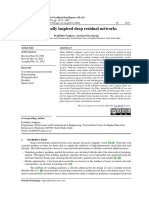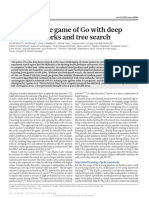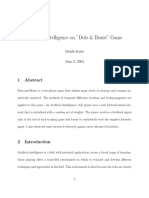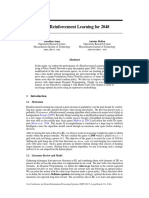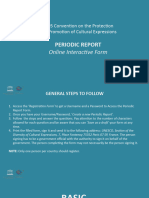Professional Documents
Culture Documents
Deep Reinforcement Learning On Atari 2600
0 ratings0% found this document useful (0 votes)
18 views3 pagesIn reinforcement learning, the traditional Qlearning method solves the game by iterating over the
full set of states. Using the Q-Table to implement QLearning is fine in small discrete environments
Original Title
Deep Reinforcement Learning on Atari 2600
Copyright
© © All Rights Reserved
Available Formats
PDF, TXT or read online from Scribd
Share this document
Did you find this document useful?
Is this content inappropriate?
Report this DocumentIn reinforcement learning, the traditional Qlearning method solves the game by iterating over the
full set of states. Using the Q-Table to implement QLearning is fine in small discrete environments
Copyright:
© All Rights Reserved
Available Formats
Download as PDF, TXT or read online from Scribd
0 ratings0% found this document useful (0 votes)
18 views3 pagesDeep Reinforcement Learning On Atari 2600
In reinforcement learning, the traditional Qlearning method solves the game by iterating over the
full set of states. Using the Q-Table to implement QLearning is fine in small discrete environments
Copyright:
© All Rights Reserved
Available Formats
Download as PDF, TXT or read online from Scribd
You are on page 1of 3
Volume 6, Issue 4, April – 2021 International Journal of Innovative Science and Research Technology
ISSN No:-2456-2165
Deep Reinforcement Learning on Atari 2600
T Manoj, J Rohit, A Sai Sashank & Asst. Prof. BJ Praveena
Dept. of Computer Science and Engineering, Matrusri Engineering College Saidabad, Telangana, India.
Abstract:- In reinforcement learning, the traditional Q II. PRELIMINARIES
Learning method solves the game by iterating over the
full set of states. Using the Q-Table to implement Q- In Q learning, the Q function, also called a state-
Learning is fine in small discrete environments. However action value function, specifies how good an action a is in
often we realize that we have too many states to track. the state s. Most of the environments have very large
An example is Atari games, that can have a large variety number of states and, in each state, we have a lot of actions
of different screens, and in this case, the problem cannot to try. It would be time-consuming to go through all the
be solved with a Q-table. This paper uses a deep neural actions in each state. A better approach would be to
network instead of a Q-table to solve it. Atari games are
approximate the Q function with some parameter . We can
displayed at a resolution of 210 by 160 pixels, with 128
possible colors for each pixel. This is still technically a use a neural network with weights to approximate the Q
discrete state space but very large to process. To reduce value for all possible actions in each state. As we are using
this complexity, we performed some minimal image neural networks to approximate the Q function, we can call
preprocessing. Finally, from the experimental results, it it a Q network.
is concluded that DQN can make the agent get high
scores from Atari game, and experience replay can Assume the environment is in a state s from the state
make the model training better. space S. The agent takes action a from the action space A by
obeying the policy (a | s). A may be discrete or
Keywords:- Deep Reinforcement Learning; Artificial continuous. When an action is performed, the agent
Intelligence; Image Processing;
transitions into a new state s ' receiving a scalar reward r. If
for every action, the reward and the next state can be
I. INTRODUCTION
observed, we can formulate the following iterative algorithm
The combination of Reinforcement Learning and Deep to learn the Q value:
Learning is Deep Reinforcement Learning (DRL). Since the
improvement of computer calculation power and processing Q(s, a) will be updated follow:
technology, deep learning has gained significant advantage Q(s, a) Q(s, a) (r Q(s, a))
than traditional methodsin the field of artificial intelligence. (1)
To use reinforcement learning successfully in situations And if the round ends, it will follow:
approaching real-world complexity, however, agents are
Q(s, a) Q(s, a) [r max Q(s ', a ') Q(s, a)]
confronted with a difficult task, they must derive efficient
a 'A
representations of the environment from high- dimensional (2)
sensory inputs, and use these to generalize past experience
to new situations. In reinforcement learning the agent does Eq. (2), which is the maximum sum of rewards r
not have knowledge on what actions to take instead, the discounted by (0 1) at each time step, achievable by a
agent learns from the consequence of its actions. Deep policy (a | s), after making an observation s and taking an
learning has strong perceptual ability but it is weak in action a with learning rate (0 1).
decision making. In contrast, reinforcement learning
performs well in decision-making, but has weak perceptual
ability [1]. Therefore, combination of these two provide a The optimal action-value function obeys the Bellman
way to solve the problem of perceptual decision-making in equation, following the intuition: if the optimal value Q(s ',
complex systems. a ') of the sequence s ' at the next time-step was known for
Here we use recent advances in training deep neural all possible actions a ', then the optimal strategy is to select
networks to develop a novel artificial agent, termed a deep the action a ' maximizing the expected value of r Q*(s ',
Q-network, that can learn successful policies directly from a ') [10]. In the Q-Learning, a policy called - greedy, that
high-dimensional sensory inputs using end-to-end
reinforcement learning on Atari 2600 games [10]. follows a greedy strategy with probability 1 - and selects a
random action with probability . will continue to decrease
with continuous training.
IJISRT21APR384 www.ijisrt.com 487
Volume 6, Issue 4, April – 2021 International Journal of Innovative Science and Research Technology
ISSN No:-2456-2165
The algorithm of DQN is presented as Figure 1. nonlinearity. The second hidden layer convolves 64 filters
of 4x4 with stride 2, again followed by a rectifier
nonlinearity. This is followed by a third convolutional layer
that convolves 64 filters of 3x3 with stride 1 followed by a
rectifier. The final hidden layer is fully-connected and
rectifier units. The output layer is a fully- connected linear
layer with a single output for each valid action [10]. The
number of valid actions in pong are 6.
Fig. 2. The RGB image with 210 x 160 pixels
Fig. 1. The Algorithm of DQN.
III. PROPOSED METHOD
The resolution of the Atari game is 210 x 160 as
shown in Fig. 2, it will clearly take a lot of computation and
memory if we feed the raw pixels directly. So, we down
sample the pixels to 84 x 84 and convert the RGB values to
grayscale values and we feed this pre-processed game
screen as the input to the model.
Fig. 3. The GRAY image with 84 x 84 pixels
Pong is a table tennis-themed arcade video game
featuring simple two-dimensional graphics, manufactured
by Atari and originally released in 1972. In Pong, one
player scores if the ball passes by the other player. An
episode is over when one of the players reaches 21 points.
In the OpenAI Gym framework version of Pong, the Agent
is displayed on the right and the enemy on the left. let’s
think carefully if with this fixed image we can determine
the dynamics of the game. There is certainly ambiguity in
the observation, we cannot know in which direction the ball
is going.
The solution is maintaining several observations from
the past and using them as a state. In the case of Atari
games, the authors of the paper suggested to stack 4
subsequent frames together and use them as the observation
at every state. For this reason, the preprocessing stacks four
frames together resulting in a final state space size of 84 x
84 x 4. The final input to the neural network is shown in
Fig. 5, which are 4 stacked grayscale images of 84 x 84
pixels each. After the images are processed, the neural
network needs to be built.
The first hidden layer convolves 32 filters of 8x8 with Fig. 4. The four subsequent frames of pong with 84 x 84
stride 4 with the input image and applies a rectifier pixels each.
IJISRT21APR384 www.ijisrt.com 488
Volume 6, Issue 4, April – 2021 International Journal of Innovative Science and Research Technology
ISSN No:-2456-2165
V. CONCLUSION
In this paper, the agent model has been created to
verify the effectiveness of experience replay. From the
training result (the agent’s average score-per-step, see Fig.
6), it can be seen that, the effect of training can grow very
slowly after about 300,000 steps. Then the agent learns
faster and more steadily.
We used the network architecture, hyperparameter
Fig. 5. Final input size (84 x 84 x 4). values and learning procedure taking high-dimensional data
as input (visual images), and the number of actions available
IV. EXPERIMENTAL RESULT in each game with only very minimal prior knowledge. Our
method was able to train large neural networks using a
In this paper, we demonstrate that DQN architecture reinforcement learning and stochastic gradient descent in a
can successfully learn control policies in the pong stable manner.
environment with only very minimal prior knowledge,
receiving only the pixels and the game score as inputs, the Finally, it can be concluded that the DQN algorithm
reward structure of the pong is as follows, Reward is 0 for combined with deep convolution neural network and some
every frame and +1 for every ball missed by other player. image processing methods can make the agent play the
The reward is -1 when ball is missed by agent. Then, In the video game well and the experience replay can improve the
process of training the model, it is possible that there will be training quality.
many cases of ineffective training.
REFERENCS
Following previous approaches to playing Atari 2600
games, we also use a simple frame-skipping technique. [1]. R. Tan, J. Zhou, H. Du, et al., An modeling processing
More precisely, the agent sees and selects actions on every method for video games based on deep reinforcement
4th frame instead of every frame, and its last action is learning, in: 2019 IEEE 8th Joint International
repeated on skipped frames. Information Technology and Artificial Intelligence
Conference, ITAIC, IEEE, 2019, pp. 939–942.
The values of all the hyperparameters and optimization [2]. SILVER D, HUANG A and et al. Mastering the game
parameters were selected by performing an informal search of Go with deep neural networks and tree search.
on the game Pong. The following are values and Nature, 2016.
descriptions of hyperparameters used in training, the [3]. Wu Xiru, Huang Guoming and Sun Lining. Fast visual
discount factor = 0.99, the planned training is 1,000,000 identification and location algorithm for industrial
steps, the initial exploration ( initial value) and the final sorting robots based on deep learning. Jiqiren/Robot,
November 1, 2016.
exploration ( final value) are 1.0 and 1e-2, respectively,
[4]. Riedmiller, M. Neural fitted Q iteration - first
and the random sampling batch size is 32. experiences with a data efficient neural reinforcement
learning method. Mach. Learn.: ECML, 3720, 317–328
Note during the experiment, the data of the average
(Springer, 2005). & Hutter, M. Universal Intelligence:
scores and the weights of neural network have been stored.
a definition of machine intelligence. Minds Mach. 17,
391–444 (2007).
Then the agent model was put to test on pong game, [5]. Moore, A. & Atkeson, C. Prioritized sweeping:
the highest scores were recorded. The Fig. 6 shows the data reinforcement learning with less data and less real
of average rewards over 1,000,000 steps trained by the time. Mach. Learn. 13, 103–130 (1993).
agent. [6]. O’Neill, J., Pleydell‐Bouverie, B., Dupret, D. &
Csicsvari, J. (2010) Play it again: reactivation of
waking experience and memory. Trends Neurosci., 33,
220– 229.
[7]. Lange, S. & Riedmiller, M. Deep auto-encoder neural
networks in reinforcement learning. Proc. Int. Jt. Conf.
Neural. Netw. 1–8 (2010).
[8]. Richard S. Sutton and Andrew G. Barto.
Reinforcement Learning. MIT Press, 1 edition, 1998.
[9]. Eric Wiewiora. Potential-based shaping and q-value
initialization are equivalent. J. Artif. Intell. Res.
(JAIR), 2003.
[10]. MNIHV, KAVUKCUOGLUK, SILVERD, et al.
Human-level control through deep reinforcement
Fig. 6. The graph plot of episode reward over 1M steps. learning[J]. Nature,2015.
IJISRT21APR384 www.ijisrt.com 489
You might also like
- Mastering Mathematica®: Programming Methods and ApplicationsFrom EverandMastering Mathematica®: Programming Methods and ApplicationsRating: 5 out of 5 stars5/5 (1)
- 111 ReportDocument6 pages111 ReportNguyễn Tự SangNo ratings yet
- Assignment3 Yash PatelDocument10 pagesAssignment3 Yash PateladyanrfutureNo ratings yet
- Human-Level Control Through Deep Reinforcement LearningDocument13 pagesHuman-Level Control Through Deep Reinforcement LearningRazielAbulafiaNo ratings yet
- Deep Q-NetworkDocument15 pagesDeep Q-Networkaishika.ranjan2021No ratings yet
- DeepMind WhitepaperDocument9 pagesDeepMind WhitepapercrazylifefreakNo ratings yet
- Assignment 3 - ReinforcementLearning - 200508263 - AdityaAnantharaman - TrikkurDocument9 pagesAssignment 3 - ReinforcementLearning - 200508263 - AdityaAnantharaman - TrikkuradyanrfutureNo ratings yet
- Learning Simple Games With Neural Networks: Kumar Ashutosh Mohd Safwan Manas VashisthaDocument6 pagesLearning Simple Games With Neural Networks: Kumar Ashutosh Mohd Safwan Manas VashisthaMohd SafwanNo ratings yet
- Learning To Play Atari Games: David Hershey, Rush Moody, Blake Wulfe (Dshersh, Rmoody, Wulfebw) @stanfordDocument6 pagesLearning To Play Atari Games: David Hershey, Rush Moody, Blake Wulfe (Dshersh, Rmoody, Wulfebw) @stanfordBakthakolahalan ShyamsundarNo ratings yet
- Proj3 Arc2Document6 pagesProj3 Arc2api-538408600No ratings yet
- Project3-Arc1 1Document7 pagesProject3-Arc1 1api-538408600No ratings yet
- Playing Atari With Deep Reinforcement Learning HighlightedDocument9 pagesPlaying Atari With Deep Reinforcement Learning HighlightedFelipe DuarteNo ratings yet
- Project 3Document23 pagesProject 3api-538408600No ratings yet
- 362 ReportDocument6 pages362 ReportNguyễn Tự SangNo ratings yet
- Advantages:: Q.No 1.a AnsDocument12 pagesAdvantages:: Q.No 1.a AnsTiwari VivekNo ratings yet
- Reinforcement Learning: R M V E R IDocument21 pagesReinforcement Learning: R M V E R IbgpexpertNo ratings yet
- Amansoftcomp PDFDocument27 pagesAmansoftcomp PDFas6858732No ratings yet
- Distributed Deep Q-Learning: Hao Yi Ong, Kevin Chavez, and Augustus HongDocument8 pagesDistributed Deep Q-Learning: Hao Yi Ong, Kevin Chavez, and Augustus HongpogNo ratings yet
- Lillicrap - Continuous Control With Deep RLDocument14 pagesLillicrap - Continuous Control With Deep RLaleong1No ratings yet
- Lab Manual On Soft Computing (IT-802) : Ms. Neha SexanaDocument29 pagesLab Manual On Soft Computing (IT-802) : Ms. Neha SexanaAdarsh SrivastavaNo ratings yet
- Lecture Notes Deep Reinforcement Learning: Generalizability in Deep RLDocument7 pagesLecture Notes Deep Reinforcement Learning: Generalizability in Deep RLRajat RaiNo ratings yet
- Simulation of The Navigation of A Mobile Robot by The Q-Learning Using Artificial Neuron NetworksDocument12 pagesSimulation of The Navigation of A Mobile Robot by The Q-Learning Using Artificial Neuron NetworkstechlabNo ratings yet
- Part 3 - Building A Deep Q-Network To Play Gridworld - Learning Instability and Target Networks - by NandaKishore Joshi - Towards Data ScienceDocument7 pagesPart 3 - Building A Deep Q-Network To Play Gridworld - Learning Instability and Target Networks - by NandaKishore Joshi - Towards Data Science배영광No ratings yet
- Case Study C NewwDocument12 pagesCase Study C NewwRudransh SharmaNo ratings yet
- DL - Assignment 5 SolutionDocument7 pagesDL - Assignment 5 Solutionswathisreejith6No ratings yet
- Playing Atari Games With Deep Reinforcement LearningDocument16 pagesPlaying Atari Games With Deep Reinforcement LearningAshvineeNo ratings yet
- RL Project - Deep Q-Network Agent ReportDocument11 pagesRL Project - Deep Q-Network Agent ReportPhạm TịnhNo ratings yet
- CS5500: Reinforcement Learning Assignment 3: Additional GuidelinesDocument7 pagesCS5500: Reinforcement Learning Assignment 3: Additional GuidelinesSHUBHAM PANCHALNo ratings yet
- ANN ManualDocument41 pagesANN ManualHemantNo ratings yet
- Chapter II - Lecture 2 - KNNDocument21 pagesChapter II - Lecture 2 - KNNHalbeega WaayahaNo ratings yet
- Learning in Feedforward Layered Networks: The Tiling AlgorithmDocument13 pagesLearning in Feedforward Layered Networks: The Tiling AlgorithmOgnjen OzegovicNo ratings yet
- 17184-77356-1-PB PDFDocument10 pages17184-77356-1-PB PDFMohd Haroon AnsariNo ratings yet
- Assignment-1: Hallenges in Executing Gradient Descent Algorithm?Document2 pagesAssignment-1: Hallenges in Executing Gradient Descent Algorithm?kn patelNo ratings yet
- Biologically Inspired Deep Residual NetworksDocument10 pagesBiologically Inspired Deep Residual NetworksIAES IJAINo ratings yet
- Deep Learning Assignment 1 Solution: Name: Vivek Rana Roll No.: 1709113908Document5 pagesDeep Learning Assignment 1 Solution: Name: Vivek Rana Roll No.: 1709113908vikNo ratings yet
- Chapter 3Document7 pagesChapter 3pavithrNo ratings yet
- Balancing A CartPole System With Reinforcement LeaDocument8 pagesBalancing A CartPole System With Reinforcement LeaKeerthana ChirumamillaNo ratings yet
- Artificial Intelligence On "Dots and Boxes" GameDocument19 pagesArtificial Intelligence On "Dots and Boxes" Gametesting33829100% (1)
- Applied Deep Learning - Part 1 - Artificial Neural Networks - by Arden Dertat - Towards Data ScienceDocument34 pagesApplied Deep Learning - Part 1 - Artificial Neural Networks - by Arden Dertat - Towards Data ScienceMonika DhochakNo ratings yet
- Machine LearningDocument73 pagesMachine LearningtesscarcamoNo ratings yet
- RL Course ReportDocument10 pagesRL Course ReportshaneNo ratings yet
- Advanced Approach To Play A Atari GameDocument6 pagesAdvanced Approach To Play A Atari GameInternational Journal of computational Engineering research (IJCER)No ratings yet
- Ee126 Project 1Document5 pagesEe126 Project 1api-286637373No ratings yet
- AlphaGo PaperDocument20 pagesAlphaGo PaperAnonymous zBGJwKNNo ratings yet
- A Deep Neural Network For Image Quality AssessmentDocument5 pagesA Deep Neural Network For Image Quality Assessmentgitov13916No ratings yet
- Playing Geometry Dash With Convolutional Neural NetworksDocument7 pagesPlaying Geometry Dash With Convolutional Neural NetworksfriedmanNo ratings yet
- Character Recognition Using Neural Networks: Rókus Arnold, Póth MiklósDocument4 pagesCharacter Recognition Using Neural Networks: Rókus Arnold, Póth MiklósSharath JagannathanNo ratings yet
- Image Processing On The GPU: A Canonical Example: Scales Ns Orientatio ColorsDocument11 pagesImage Processing On The GPU: A Canonical Example: Scales Ns Orientatio ColorsserkantokayNo ratings yet
- Artificial Intelligence On "Dots & Boxes" Game: Mehdi Kabir June 2, 2004Document19 pagesArtificial Intelligence On "Dots & Boxes" Game: Mehdi Kabir June 2, 2004Devashish RajNo ratings yet
- 6COM1044 Deep Learning 1Document49 pages6COM1044 Deep Learning 1Amir Mohamed Nabil Saleh ElghameryNo ratings yet
- Exploring Game Playing AI Using Reinforcement Learning TechniquesDocument5 pagesExploring Game Playing AI Using Reinforcement Learning Techniquesdhanushdarshan7No ratings yet
- Deep Learning PDFDocument55 pagesDeep Learning PDFNitesh Kumar SharmaNo ratings yet
- A Probabilistic Theory of Deep Learning: Unit 2Document17 pagesA Probabilistic Theory of Deep Learning: Unit 2HarshitNo ratings yet
- An Automated Multi Scale RETINEX With Color Restoration For Image EnhancementDocument5 pagesAn Automated Multi Scale RETINEX With Color Restoration For Image EnhancementNIRANJAN MEHARNo ratings yet
- RL 2048Document10 pagesRL 2048user12No ratings yet
- Assignment - 4Document24 pagesAssignment - 4Durga prasad TNo ratings yet
- AI A Z HandBookDocument12 pagesAI A Z HandBookEsteban Ignacio Melendez OsechasNo ratings yet
- Research paperFYPDocument8 pagesResearch paperFYPALI DEXTERNo ratings yet
- Alpha Go Nature PaperDocument20 pagesAlpha Go Nature PaperSimon ChenNo ratings yet
- Detection and Counting of Fake Currency & Genuine Currency Using Image ProcessingDocument6 pagesDetection and Counting of Fake Currency & Genuine Currency Using Image ProcessingInternational Journal of Innovative Science and Research Technology100% (9)
- An Overview of Lung CancerDocument6 pagesAn Overview of Lung CancerInternational Journal of Innovative Science and Research TechnologyNo ratings yet
- Entrepreneurial Creative Thinking and Venture Performance: Reviewing the Influence of Psychomotor Education on the Profitability of Small and Medium Scale Firms in Port Harcourt MetropolisDocument10 pagesEntrepreneurial Creative Thinking and Venture Performance: Reviewing the Influence of Psychomotor Education on the Profitability of Small and Medium Scale Firms in Port Harcourt MetropolisInternational Journal of Innovative Science and Research TechnologyNo ratings yet
- Digital Finance-Fintech and it’s Impact on Financial Inclusion in IndiaDocument10 pagesDigital Finance-Fintech and it’s Impact on Financial Inclusion in IndiaInternational Journal of Innovative Science and Research TechnologyNo ratings yet
- Impact of Stress and Emotional Reactions due to the Covid-19 Pandemic in IndiaDocument6 pagesImpact of Stress and Emotional Reactions due to the Covid-19 Pandemic in IndiaInternational Journal of Innovative Science and Research TechnologyNo ratings yet
- Auto Tix: Automated Bus Ticket SolutionDocument5 pagesAuto Tix: Automated Bus Ticket SolutionInternational Journal of Innovative Science and Research TechnologyNo ratings yet
- Designing Cost-Effective SMS based Irrigation System using GSM ModuleDocument8 pagesDesigning Cost-Effective SMS based Irrigation System using GSM ModuleInternational Journal of Innovative Science and Research TechnologyNo ratings yet
- Computer Vision Gestures Recognition System Using Centralized Cloud ServerDocument9 pagesComputer Vision Gestures Recognition System Using Centralized Cloud ServerInternational Journal of Innovative Science and Research TechnologyNo ratings yet
- Effect of Solid Waste Management on Socio-Economic Development of Urban Area: A Case of Kicukiro DistrictDocument13 pagesEffect of Solid Waste Management on Socio-Economic Development of Urban Area: A Case of Kicukiro DistrictInternational Journal of Innovative Science and Research TechnologyNo ratings yet
- Utilization of Waste Heat Emitted by the KilnDocument2 pagesUtilization of Waste Heat Emitted by the KilnInternational Journal of Innovative Science and Research TechnologyNo ratings yet
- Ambulance Booking SystemDocument7 pagesAmbulance Booking SystemInternational Journal of Innovative Science and Research TechnologyNo ratings yet
- Predictive Analytics for Motorcycle Theft Detection and RecoveryDocument5 pagesPredictive Analytics for Motorcycle Theft Detection and RecoveryInternational Journal of Innovative Science and Research TechnologyNo ratings yet
- Smart Cities: Boosting Economic Growth Through Innovation and EfficiencyDocument19 pagesSmart Cities: Boosting Economic Growth Through Innovation and EfficiencyInternational Journal of Innovative Science and Research TechnologyNo ratings yet
- Factors Influencing The Use of Improved Maize Seed and Participation in The Seed Demonstration Program by Smallholder Farmers in Kwali Area Council Abuja, NigeriaDocument6 pagesFactors Influencing The Use of Improved Maize Seed and Participation in The Seed Demonstration Program by Smallholder Farmers in Kwali Area Council Abuja, NigeriaInternational Journal of Innovative Science and Research TechnologyNo ratings yet
- Study Assessing Viability of Installing 20kw Solar Power For The Electrical & Electronic Engineering Department Rufus Giwa Polytechnic OwoDocument6 pagesStudy Assessing Viability of Installing 20kw Solar Power For The Electrical & Electronic Engineering Department Rufus Giwa Polytechnic OwoInternational Journal of Innovative Science and Research TechnologyNo ratings yet
- Forensic Advantages and Disadvantages of Raman Spectroscopy Methods in Various Banknotes Analysis and The Observed Discordant ResultsDocument12 pagesForensic Advantages and Disadvantages of Raman Spectroscopy Methods in Various Banknotes Analysis and The Observed Discordant ResultsInternational Journal of Innovative Science and Research TechnologyNo ratings yet
- Cyber Security Awareness and Educational Outcomes of Grade 4 LearnersDocument33 pagesCyber Security Awareness and Educational Outcomes of Grade 4 LearnersInternational Journal of Innovative Science and Research TechnologyNo ratings yet
- Unmasking Phishing Threats Through Cutting-Edge Machine LearningDocument8 pagesUnmasking Phishing Threats Through Cutting-Edge Machine LearningInternational Journal of Innovative Science and Research TechnologyNo ratings yet
- An Industry That Capitalizes Off of Women's Insecurities?Document8 pagesAn Industry That Capitalizes Off of Women's Insecurities?International Journal of Innovative Science and Research TechnologyNo ratings yet
- Blockchain Based Decentralized ApplicationDocument7 pagesBlockchain Based Decentralized ApplicationInternational Journal of Innovative Science and Research TechnologyNo ratings yet
- Smart Health Care SystemDocument8 pagesSmart Health Care SystemInternational Journal of Innovative Science and Research TechnologyNo ratings yet
- Visual Water: An Integration of App and Web To Understand Chemical ElementsDocument5 pagesVisual Water: An Integration of App and Web To Understand Chemical ElementsInternational Journal of Innovative Science and Research TechnologyNo ratings yet
- Parastomal Hernia: A Case Report, Repaired by Modified Laparascopic Sugarbaker TechniqueDocument2 pagesParastomal Hernia: A Case Report, Repaired by Modified Laparascopic Sugarbaker TechniqueInternational Journal of Innovative Science and Research TechnologyNo ratings yet
- Implications of Adnexal Invasions in Primary Extramammary Paget's Disease: A Systematic ReviewDocument6 pagesImplications of Adnexal Invasions in Primary Extramammary Paget's Disease: A Systematic ReviewInternational Journal of Innovative Science and Research TechnologyNo ratings yet
- Impact of Silver Nanoparticles Infused in Blood in A Stenosed Artery Under The Effect of Magnetic Field Imp. of Silver Nano. Inf. in Blood in A Sten. Art. Under The Eff. of Mag. FieldDocument6 pagesImpact of Silver Nanoparticles Infused in Blood in A Stenosed Artery Under The Effect of Magnetic Field Imp. of Silver Nano. Inf. in Blood in A Sten. Art. Under The Eff. of Mag. FieldInternational Journal of Innovative Science and Research TechnologyNo ratings yet
- Insights Into Nipah Virus: A Review of Epidemiology, Pathogenesis, and Therapeutic AdvancesDocument8 pagesInsights Into Nipah Virus: A Review of Epidemiology, Pathogenesis, and Therapeutic AdvancesInternational Journal of Innovative Science and Research TechnologyNo ratings yet
- Compact and Wearable Ventilator System For Enhanced Patient CareDocument4 pagesCompact and Wearable Ventilator System For Enhanced Patient CareInternational Journal of Innovative Science and Research TechnologyNo ratings yet
- Parkinson's Detection Using Voice Features and Spiral DrawingsDocument5 pagesParkinson's Detection Using Voice Features and Spiral DrawingsInternational Journal of Innovative Science and Research TechnologyNo ratings yet
- Air Quality Index Prediction Using Bi-LSTMDocument8 pagesAir Quality Index Prediction Using Bi-LSTMInternational Journal of Innovative Science and Research TechnologyNo ratings yet
- Predict The Heart Attack Possibilities Using Machine LearningDocument2 pagesPredict The Heart Attack Possibilities Using Machine LearningInternational Journal of Innovative Science and Research TechnologyNo ratings yet
- Java MCQ Set - 1 IXDocument2 pagesJava MCQ Set - 1 IXRGRC ITES CENTUM WBNo ratings yet
- Diebold I and IX Training Manual SampleDocument36 pagesDiebold I and IX Training Manual SampleOmar ShawkyNo ratings yet
- MIS605 Systems Analysis and DesignDocument5 pagesMIS605 Systems Analysis and DesignAbhilasha Dahiya100% (1)
- Barangay Management SystemDocument59 pagesBarangay Management SystemLuis Laluna AbawagNo ratings yet
- Flexi Multiradio 10 Base Station Transmission DescriptionDocument27 pagesFlexi Multiradio 10 Base Station Transmission DescriptionMohamedNasser Gad El MawlaNo ratings yet
- Procedure For Submission of Eforms For Creation of NIC E-Mail IDDocument10 pagesProcedure For Submission of Eforms For Creation of NIC E-Mail IDKrishNo ratings yet
- QPR Tutorial 2016 enDocument36 pagesQPR Tutorial 2016 enJamie MendozaNo ratings yet
- Virtualize More, Manage Less: IBM System Storage SAN Volume ControllerDocument67 pagesVirtualize More, Manage Less: IBM System Storage SAN Volume ControllerfqchinaNo ratings yet
- Platform License Agreement 12 Sept 2023Document8 pagesPlatform License Agreement 12 Sept 2023voot00voot2326No ratings yet
- Real-Time Operating Systems: Read Chapter 6 (David E. Simon, An Embedded Software Primer)Document28 pagesReal-Time Operating Systems: Read Chapter 6 (David E. Simon, An Embedded Software Primer)bhargava PrasadNo ratings yet
- TextbooksDocument3 pagesTextbooksanilknambiarNo ratings yet
- CUEGIS Essay - Apple: Question: What Was The Effect of Change and Globalization On Apple's Growth?Document5 pagesCUEGIS Essay - Apple: Question: What Was The Effect of Change and Globalization On Apple's Growth?Ahan Korde100% (1)
- All Domains Real Project Explanation IMPDocument4 pagesAll Domains Real Project Explanation IMPapi-384061794% (18)
- Octopus 301Document50 pagesOctopus 301morano.matteo97No ratings yet
- KX-21 Sysmex HostDocument15 pagesKX-21 Sysmex HostDaniel100% (1)
- 4K X 2K Embedded ATC Display: GF VT 16 MidasDocument2 pages4K X 2K Embedded ATC Display: GF VT 16 MidasJoaoNo ratings yet
- Clevo d900k Sager np9750 PDFDocument96 pagesClevo d900k Sager np9750 PDFSelmar CavalcantiNo ratings yet
- TMS370 ICP Users Manual Rev1 3Document10 pagesTMS370 ICP Users Manual Rev1 3Lotfi Ben SlimNo ratings yet
- Super Premium: February 2 0 1 7Document2 pagesSuper Premium: February 2 0 1 7Siddharth SanghaviNo ratings yet
- Adb Cheatsheet PDFDocument1 pageAdb Cheatsheet PDFPeri80% (5)
- DBMS Lab Manual-CseDocument45 pagesDBMS Lab Manual-Cse20BECSE028 KIRUBANANDHAM KNo ratings yet
- nuBuilderForte UserGuideDocument69 pagesnuBuilderForte UserGuideJemal DawudNo ratings yet
- Aukey BluetoothDocument1 pageAukey BluetoothJavier FernándezNo ratings yet
- WEKA Lab ManualDocument107 pagesWEKA Lab ManualRamesh Kumar100% (1)
- LG Flatron l204wt-sf. Service ManualDocument27 pagesLG Flatron l204wt-sf. Service ManualAnonymous Ofyabixh8100% (2)
- CCNA 1 v6 Chapter 3Document8 pagesCCNA 1 v6 Chapter 3Webber JonxNo ratings yet
- SAGE Pipeline DesignDocument5 pagesSAGE Pipeline DesignSanjivaniNo ratings yet
- Azure Portal TerminologyDocument2 pagesAzure Portal TerminologyyNo ratings yet
- Computer Security NotesDocument28 pagesComputer Security NotesDr. Sandeep SaxenaNo ratings yet
- Flowgorithm - Documentation - ExpressionsDocument2 pagesFlowgorithm - Documentation - ExpressionsistiqlalNo ratings yet





